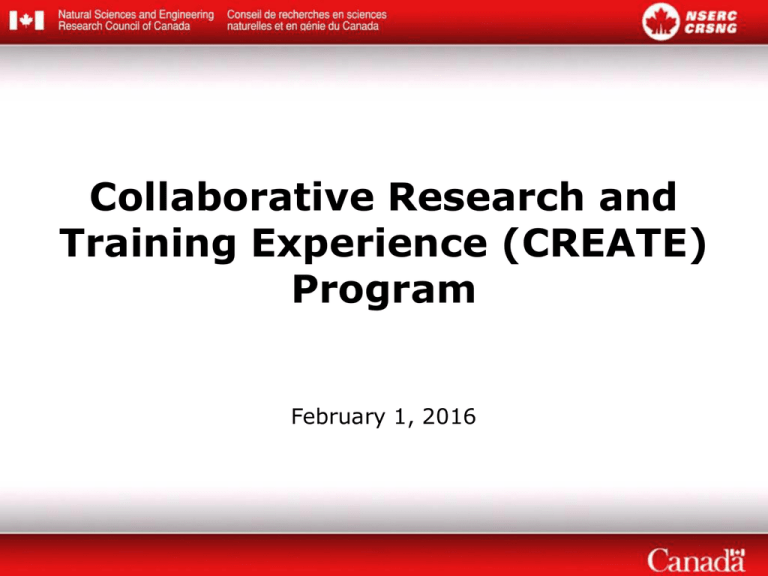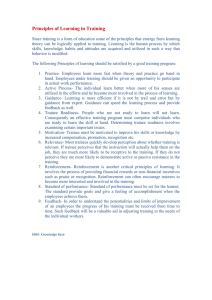Collaborative Research and Training Experience (CREATE) Program February 1, 2016
advertisement

Collaborative Research and Training Experience (CREATE) Program February 1, 2016 Welcome • • • • Team Leader: Teresa Jurewicz Program Officer (post-award): Lauren Remmler Program Officer (competition): Paule Boulanger Program Assistant: Lise Bériault CREATE@NSERC-CRSNG.GC.CA • Program overview • Application process • Selection criteria http://www.nserc-crsng.gc.ca/professorsprofesseurs/grants-subs/create-foncer_eng.asp Program objectives CREATE supports the training of students and postdoctoral fellows from Canada and abroad through the development of innovative training programs that: • • encourage collaborative and integrative approaches that address significant scientific challenges facilitate the transition of new researchers from trainees to productive employees in the Canadian workforce CREATE encourages • Enriched training experiences • Improved job readiness • Professional skills development • Industrial collaboration • Student mobility • Interdisciplinary research* Qualities of successful CREATE initiatives – Innovative nature – Rich training environment – Excellence of the researchers and their training success – Capacity to raise the standard for best practices in training – Promoting collaboration and international awareness Value of the Grant Year 1: up to $150,000 Years 2 – 6*: up to $300,000 per year Total: up to $1,650,000 Non renewable Expectations *Year 2-6 funding is dependent on positive performance evaluations by NSERC. Regular progress reports are required Must demonstrate that proposed objectives, training elements, HQP targets, etc., are being met. i.e. applicants are held accountable and must follow through on what is promised in the proposals. Allowable expenses • At least 80% to trainee stipends • Up to 30% of this may go toward non-NSE trainees • Remaining 20% may be used for… Trainee travel (conferences, exchanges, internships, etc). Training program administration (e.g. salary of program coordinator; first 2 years only) Dissemination of training materials etc. Note that travel costs of the applicants and collaborators are not eligible. Trainee stipends • No minimum or maximum • May be complemented by other sources • Supervisors • Collaborators • Scholarships • stipend from CREATE is not a requirement for trainee participation in the initiative • Emphasis of the initiative must be on graduate students, but undergraduate and postdoctoral trainees may also be supported Teams leading CREATE initiatives • A complementary group of researchers • From eligible Canadian universities • For multi-university applications: must have at least one co-applicant involved for trainees at that institution to be eligible to receive CREATE stipends • Work collaboratively to offer a defined training program to a group of trainees • Supporting Gender Representation and Advancement Teams leading CREATE initiatives Conditions • Tenable at NSERC-eligible Canadian universities • Lead applicant must be from an NSERC-supported field at an NSERC-eligible university • At least 70% of the group must be in NSE (co-applicants may be from other fields) • Participation in maximum of two active CREATE initiatives Program committee Program committee (PC) consisting of a variety of stake holders, e.g. • Potential future employers of graduates • Collaborators • Curriculum developers • Trainees Program evaluation and guidance Addressing Research Priorities At least 60% of CREATE funding will be directed to priority areas: • Environmental science and technologies • Natural resources and energy • Manufacturing • Information and communications technologies Streams Regular stream CREATE may involve any collaborations: academic/government/industry/NGO, Canadian/international CREATE + Germany’s DFG-IRTG: for collaboration with German researchers CREATE + Sao Paulo’s FAPESP: for collaboration with Sao Paulo researchers Industrial stream CREATE: required industrial participation Industrial Stream Up to 50% of CREATE grants are dedicated to industrial stream applications. - Increased emphasis on preparing trainees for non-academic careers; enhanced academic-industrial collaboration - Requires participation of industrial collaborators on the program committee - Requires industrial internships of at least 20% of their studies Industrial collaborators • Canadian-based businesses, able to exploit the research results for the economic benefit of Canada. • International companies eligible if activities related to the proposed research take place in Canada (e.g. R&D, manufacturing); if their participation will result in a benefit to Canada. Application Procedures Phase 1: Letter of Intent Phase 2: Application (if invited) Phase 1: Letter of Intent Selection process & criteria 1. Internal selection at university (quota based) 2. CREATE Selection Committee • Merit of proposed training program (60%) • Excellence of the research team (40%) Phase 1: Letter of Intent Form 187: Letter of Intent to Apply for a CREATE • List co-applicants (min 1, max 10) • Collaborators • Referee suggestions (6) • LOIs will not be sent for external review Phase 1: Letter of Intent Personal Data Form (Form 100) Letter from VP Research of the lead university Phase 1: Letter of Intent Outline of Training Program (2 pages) • Objectives • Novelty • How trainees would be better prepared for careers • Involvement of stakeholders • Description of potential future employers, assessment of job prospects for trainees Phase 1: Letter of Intent Excellence of Proposed Team (2 pages) • Complementarities • Expertise • Roles, responsibilities • Training experience Phase 2: Full application Selection process & criteria Only if invited Criteria: • Merit of proposed training program (50%) • Excellence of the research team (25%) • Program management and sustainability (25%) Phase 2: Full application Personal data form (Form 100) for the applicant Personal data form (Form 100) or CCV for all coapplicants (max 10) One letter from the lead applicant’s university • Support, financial commitments Up to 3 letters from collaborators, if applicable • Nature of support Phase 2: Full application Form 102 – Application for a CREATE grant • Application profile • Plain language summary of proposal • Co-applicants and collaborators • Proposed expenditures Phase 2: Full application Research training program proposal (free-form, 12 pages + 1 for references) • Objectives • Elements of the training program • Estimated number of trainees • Job prospects • Program Committee Phase 2: Full application Budget justification (free form, 2 pages) Support from other sources (free form, 2 pages) Maximum 1 Letter of support from lead university: • List of all contributions from the university • Describe the details of support • Involvement in the training program • Plans to ensure sustainability Additional requirements for industrial stream applications • Skills identified as needed for a career in industry • Description of improved job-readiness for industry sector • Details about trainee internships Additional application requirements for industrial stream Letter of Intent (phase 1) ONE e-mail/letter from industry partner confirming: • Willingness to participate on the program committee • Intent to host internships Additional application requirements for industrial stream Application (phase 2) Max 3 letter(s) from industry partner(s) confirming • Commitment to participate on the program committee, with confirmed name of the industrial member • Commitment to host trainee internships of at least 20% of the duration of trainees’ studies. Agreements must be in place and should be guaranteed (may be dependent on success of application). Application procedures for DFG collaborations Phase 1 Pre-proposal at DFG Phase 2 German researchers submit full application to DFG Canadian researchers submit full application to NSERC Application procedures for FAPESP collaborations • LOI at NSERC with brief joint plan • Application at NSERC and FAPESP review • Selection process • Funding decision Competition statistics 2013 2014 2015 2016 LOIs received: 103 120 125 114 Candidates invited: 50 48 48 52 Applications received: 48 47 45 52 Grants awarded: 15 15 17 Up to 17 Important Dates March/April: Letter of Intent deadline (Univ.) May Letter of Intent deadline (NSERC) 1: June 30: Invitation to submit application September 22: Application deadline (NSERC) March: Notification of results Program description: http://www.nserccrsng.gc.ca/professor s-professeurs/grantssubs/createfoncer_eng.asp Information • Program description: www.nserc-crsng.gc.ca/ProfessorsProfesseurs/Grants-Subs/CREATE-FONCER_eng.asp • • • • Team Leader: Teresa Jurewicz Program Officer (competition): Paule Boulanger Program Officer (post-award): Lauren Remmler Program Assistant: Lise Bériault • E-mail: CREATE@nserc-crsng.gc.ca • Tel:613-943-1363

